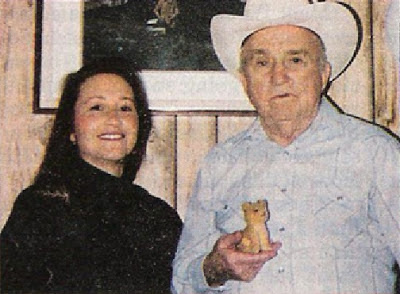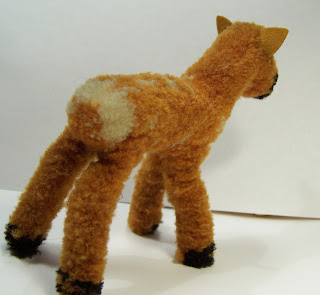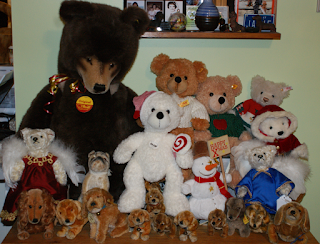"When I was a boy and I would see scary things in the news, my mother would say to me, 'Look for the helpers. You will always find people who are helping.' To this day, especially in times of 'disaster,' I remember my mother’s words, and I am always comforted by realizing that there are still so many helpers - so many caring people in this world."
-- Mister Rogers
In this season of love and hope, Steiffgal wishes to share a remarkable and inspirational story - which of course has a Steiff connection!It goes without saying that you have heard of the horror that visited the Sandy Hook Elementary School in Newtown, Connecticut, USA. Come hear what two Steiff superfans did when they heard the news that 26 innocents were killed in this unprecedented school shooting.
Steiffgal: Please tell us your names, where you live, and a little bit about yourself?
Jamie Prata-Gomes: My name is Jamie Prata-Gomes and my husband is Adam Gomes. We live in East Freetown, MA. Adam spends most of his time working in IT, specifically network security. Due to my current health issues, I am unable to work right now. I spend my days caring for our dachshunds and cats, reading, staying current on IT industry advances, helping to run South Coast Innovator Labs, and loving my stuffy collection! Adam and I enjoy seeking out Steiff collectibles and other stuffies any way we can when we have the time.
Steiffgal: Can you tell us about your interest in Steiff?
![]() Jamie: My interest in Steiff began very young. I've always loved and collected stuffed animals and knew of Steiff from as far back as I can remember. When I was a child, finances were tight. It was much easier for my family to find deals on other brands of stuffed animals and I never went without. Fast forward a few years, and I hit a very rough patch and I lost my beloved mother and adoptive father. We also had some house issues and I was diagnosed with a rare interstitial lung disease; today I am in chemotherapy for it. Adam was very supportive and asked me to find a new stuffy I wanted and we would go buy it. On a whim, I looked up Steiff online and found that the warehouse was a few towns over in Raynham, MA and they had a small store right there! We took the short drive to Raynham and entered one of the happiest places on earth! I went back to the store weekly and bought many wonderful items that helped me through a difficult time and has continued to bring a lot of happiness to me and to Adam.
Jamie: My interest in Steiff began very young. I've always loved and collected stuffed animals and knew of Steiff from as far back as I can remember. When I was a child, finances were tight. It was much easier for my family to find deals on other brands of stuffed animals and I never went without. Fast forward a few years, and I hit a very rough patch and I lost my beloved mother and adoptive father. We also had some house issues and I was diagnosed with a rare interstitial lung disease; today I am in chemotherapy for it. Adam was very supportive and asked me to find a new stuffy I wanted and we would go buy it. On a whim, I looked up Steiff online and found that the warehouse was a few towns over in Raynham, MA and they had a small store right there! We took the short drive to Raynham and entered one of the happiest places on earth! I went back to the store weekly and bought many wonderful items that helped me through a difficult time and has continued to bring a lot of happiness to me and to Adam.
Steiffgal: Tell us how you heard about the shootings in Newtown, which took place on Friday morning, December 14th.
Jamie: Because of my lung condition and treatment, I had been really sick Thursday night. As a result, I stayed in bed and napped most of Friday. Adam was working from home, but he hadn't had the television or radio on. Around 3 PM, I was feeling better and I got up to shower and dress. I noticed that a friend sent a message on Facebook about a tragedy in Newtown, CT.My maternal grandfather was born and raised a few towns away. I have many fond memories of visiting him when I was a small child, and visiting his grave and the general area with my mother in later years.All of this was in my mind when Adam and I ran to turn on the television. When we saw the news accounts, our hearts just broke and I actually started crying. Adam was speechless and I was so lost that I was shaking. I just kept thinking, "These poor children. This poor community. Things like this don't happen in New England. These poor children."
Steiffgal: What happened next?
Jamie: I realized I had grabbed one of my stuffed animals, and was holding her tight like I do so much. That's when it hit me: Anytime something bad happens in my life, I miss my lost loved ones, or I just don't feel well, I grab one of my stuffies. I can't even begin to imagine losing a child or being a child in this situation. These children who have just survived the horror of what happened in their school and community need something to hold on to. They need stuffed friend to hug while they try to process what has happened, while they try to grieve, while they try to make sense of this, and while they try to find a new normal.
Steiffgal: And apparently you immediately got to work in making that happen. Tell us how.
Jamie: I started searching through my collection for stuffed toys that still are still new and have the tags and such and that I thought children aged kindergarten through fourth grade would enjoy. In a few minutes I had gathered about 50 such stuffed toys from my collection. Poor Adam was having a hard time keeping up with my thoughts and I had asked him to try to find out where we could bring them in Newtown, CT... that night! He talked me out of that one because it would take about 3 hours just to get there. Adam made a lot of phone calls and finally reached the Newtown police department. They thanked us and asked us to call back in the morning for directions on where we could drop off the stuffed toys. I was already on to a new evolution of the plan. I had heard on the news that there were approximately 600 students at Sandy Hook Elementary School. I decided we should reach out to anyone we could get a hold of and ask them to help us gather up 600 new or like new stuffed toys for us to drive to Newtown, CT on Saturday. At this point, it was already 5:30 PM on Friday and I didn't know if we'd even come close to our goal but I wasn't going to stop until we brought as many stuffies as possible to those children.
Steiffgal: This truly was a team effort between you and Adam.
Jamie: Yes, Adam, who had worked all day, was right there making phone calls, organizing my thoughts, making plans for the trip, and budgeting our money to buy as many stuffies as we could. At his suggestion, we both started posting on our Facebook pages to try to reach as many people as possible. We weren't sure we would be able to reach anyone: it was a Friday evening, Hanukkah, and so close to Christmas. We knew a lot of people would be shopping and celebrating the holidays. Many friends and family members did see our posts on Facebook, our text messages, and our phone numbers on their caller IDs. Many, many wonderful people donated new stuffed animals and many handed us money or sent money to our PayPal account and asked us to buy stuffed animals from them.
Steiffgal: Tell us how you managed to get 600 stuffies to bring to Newtown.
![]()
Jamie: Adam and I immediately set out to buy stuffed animals. We decided to start at Kohl's (a major US department store) because they have the "Kohl's Cares For Kids" stuffed animals. Our reasoning was that we could buy a lot of stuffed animals for $5 each, the proceeds from those stuffed animals go to children's charities, and they are really cute. We ended up buying just about all of the Kohl's Cares stuffed animals in Taunton, MA, which is near our hometown. Our dear friends met at another local Kohl's. We bought most of the stuffies from that store as well. The Managers at each Kohl's looked for extra stock to give us, cleared the way for us to check out quickly so we could do as much as possible, and promised to spread the word about what we were doing to encourage others to reach out to Newtown and help anyway possible. At that point, we had reached close to 300 stuffed animals! Adam's parents were also involved in our efforts; they had gone to a Kohl's in their area bought most of their Kohl's Cares stuffies. They also went to another store and bought more stuffed animals. Then we headed off to Ocean State Job Lot (a New England based discount store) where we bought about 100 more stuffies. By 11PM on Friday night - just 8 hours of first hearing of the news - we had reached almost 500 stuffed toys, thanks to our wonderful friends and family members, and some wonderful strangers! Late Friday night, we started planning for the trip to Newtown in the morning.
Steiffgal: Then it was time to hit the road.
Jamie:Yes. At 7 AM on Saturday, we loaded up our SUV and headed to Newtown. We stopped in Providence, RI to pick up donations that had come available overnight. We also stopped at another Ocean State Job Lot on our way and bought another 100 stuffed animals to meet our goal. After about 3 hours of driving and a few stops we reached Newtown, CT. I wasn't feeling all that well, but we were on a mission and nothing would stop me from getting those stuffies to the children of Newtown. Adam had been in touch with the Newtown Police Department and the Newtown Social Services people during our trip out there and we were welcomed into the police department/social services building.
Steiffgal: What happened when you arrived in Newtown?
Jamie: Many people came to our aid and unloaded all of the 600 stuffed toys from our truck. There were many thank you wishes, moist eyes, and hugs fromthose grieving community members. We just wanted to get these stuffedfriends to the children as quickly as possible because they need something to hold on to and hug. The children need to know that there are so many people who care and want them to have a childhood in spite of this unimaginable tragedy.
We didn't stay long because there was a lot of chaos as everyone tried to get through the shock of what had happened the day before and figure out what to do for his or her community next. Adam and I didn't want to be in the way. We did take a few moments to view the town as we were leaving it - I hadn't been to the area in over 5 years and Adam had been through the area, but never to the area. It was a difficult ride home because Adam and I wanted to do more, but at least the children have these stuffed toys to hug. We will continue to stay in contact with Newtown, CT to offer whatever support we can.
Steiffgal: You are both truly heroes. If other people want to contribute, how can they do so?
Jamie: Probably the best way is through a donation drive by the United Way and the Newtown Savings Bank. Click here to learn more.
Steiffgal: Your story is awe-inspiring. Thank you from all of us for your kindness.
Have a question about one of your Steiff treasures? Let's talk! Click here to learn more.






















































































